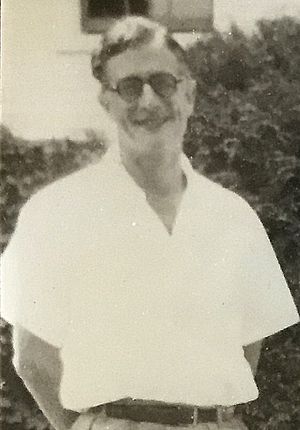Frank Yates facts for kids
Frank Yates (born May 12, 1902 – died June 17, 1994) was a very important scientist in the field of statistics during the 20th century. He helped create many new ways to use numbers and data. He was known for his work in designing experiments and using computers for science.
Contents
Early Life and Education
Frank Yates was born in Manchester, England, on May 12, 1902. He was the oldest of five children. His father, Percy Yates, sold seeds and was also a botanist, someone who studies plants.
Frank went to Wadham House, a private school. In 1916, he earned a scholarship to Clifton College. Later, in 1920, he received another scholarship to St John's College, Cambridge. Four years later, he graduated with top honors.
Early Career and Travels
After college, Frank taught mathematics at Malvern College for two years. Then, he traveled to Africa. There, he worked as a math advisor for the Gold Coast Survey. He later returned to England because he wasn't feeling well.
Frank Yates was married three times. He first married Margaret Forsythe Marsden. Later, he married Prascovie (Pauline) Tchitchkine. After she passed away in 1976, he married Ruth Hunt, who had been his secretary for a long time.
Contributions to Statistics
In 1931, Frank Yates joined the Rothamsted Experimental Station. He worked there as an assistant statistician for a famous scientist named R.A. Fisher.
Leading the Statistics Department
In 1933, R.A. Fisher moved to University College London. Frank Yates then became the head of the statistics department at Rothamsted.
At Rothamsted, he did very important work on how to design experiments. This included helping to create the theory of analysis of variance. This is a way to understand how different factors affect an outcome in an experiment. He also developed Yates's algorithm and a method called balanced incomplete block design. These tools help scientists get the best results from their experiments.
World War II Work
During World War II, Frank Yates worked on something called operations research. This field uses math and science to help make better decisions, especially in complex situations like wartime planning.
Computers and Later Career
After World War II, Frank Yates focused on designing and analyzing sample surveys. These are surveys where only a small part of a group is studied to learn about the whole group.
Pioneering Computer Use
Frank Yates was very excited about electronic computers. In 1954, he helped Rothamsted get an Elliott 401 computer. He also played a big part in the early development of statistical computing, which is using computers to do statistical calculations.
From 1960 to 1961, he was the President of the British Computer Society. He received the Guy Medal in Gold in 1960 and the Royal Medal in 1966 for his amazing work.
Frank Yates retired from Rothamsted to become a senior research fellow at Imperial College London. He passed away in 1994 at the age of 92 in Harpenden.
Key Publications
Frank Yates wrote several important books and papers that helped shape the field of statistics:
- The design and analysis of factorial experiments (1937)
- Statistical tables for biological, agricultural and medical research (1938, with R.A. Fisher)
- Sampling methods for censuses and surveys (1949)
- He also helped create computer programs like GENFAC, RGSP, and Fitquan.
See also
- Fisher–Yates shuffle
- Yates analysis
- Yates's correction for continuity


